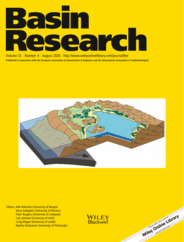
Full text loading...
In the northwestern sector of the Zagros foreland basin, axial fluvial systems initially delivered fine‐grained sediments from northwestern source regions into a contiguous basin, and later transverse fluvial systems delivered coarse‐grained sediments from northeastern sources into a structurally partitioned basin by fold‐thrust deformation. Here we integrate sedimentologic, stratigraphic, palaeomagnetic and geochronologic data from the northwestern Zagros foreland basin to define the Neogene history of deposition and sediment routing in response to progressive advance of the Zagros fold‐thrust belt. This study constrains the depositional environments, timing of deposition and provenance of nonmarine clastic deposits of the Injana (Upper Fars), Mukdadiya (Lower Bakhtiari) and Bai‐Hasan (Upper Bakhtiari) Formations in the Kurdistan region of Iraq. Sediments of the Injana Formation (~12.4–7.75 Ma) were transported axially (orogen‐parallel) from northwest to southeast by meandering and low‐sinuosity channel belt system. In contrast, during deposition of the Mukdadiya Formation (~7.75–5 Ma), sediments were delivered transversely (orogen‐perpendicular) from northeast to southwest by braided and low‐sinuosity channel belt system in distributive fluvial megafans. By ~5 Ma, the northwestern Zagros foreland basin became partitioned by growth of the Mountain Front Flexure and considerable gravel was introduced in localized alluvial fans derived from growing topographic highs. Foredeep accumulation rates during deposition of the Injana, Mukdadiya and Bai‐Hasan Formations averaged 350, 400 and 600 m/Myr respectively, suggesting accelerated accommodation generation in a rapidly subsiding basin governed by flexural subsidence. Detrital zircon U‐Pb age spectra show that in addition to sources of Mesozoic‐Cenozoic cover strata, the Injana Formation was derived chiefly from Palaeozoic‐Precambrian (including Carboniferous and latest Neoproterozoic) strata in an axial position to the northwest, likely from the Bitlis‐Puturge Massif and broader Eastern Anatolia. In contrast, the Mukdadiya and Bai‐Hasan Formations yield distinctive Palaeogene U‐Pb age peaks, particularly in the southeastern sector of the study region, consistent with transverse delivery from the arc‐related terranes of the Walash and Naopurdan volcano‐sedimentary groups (Gaveh‐Rud domain?) and Urumieh‐Dokhtar magmatic arc to the northeast. These temporal and spatial variations in stratigraphic framework, depositional environments, sediment routing and compositional provenance reveal a major drainage reorganization during Neogene shortening in the Zagros fold‐thrust belt. Whereas axial fluvial systems initially dominated the foreland basin during early orogenesis in the Kurdistan region of Iraq, transverse fluvial systems were subsequently established and delivered major sediment volumes to the foreland as a consequence of the abrupt deformation advance and associated topographic growth in the Zagros.

Article metrics loading...

Full text loading...
References


Data & Media loading...

